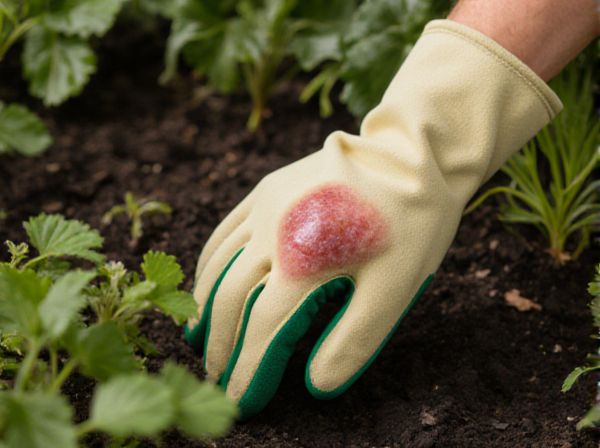
Bacterial Canker vs Fungal Canker Illustration
Bacterial canker causes dark, sunken lesions and often oozes a sticky substance, while fungal canker typically presents as dry, cracked, and necrotic areas on stems or branches. Both diseases disrupt nutrient flow and weaken plant structures but require different treatment approaches; bacterial canker responds to copper-based bactericides, whereas fungal canker is managed through fungicides and pruning of infected tissue. Accurate diagnosis is crucial to prevent spread and minimize damage in affected crops.
Table of Comparison
| Feature | Bacterial Canker | Fungal Canker |
|---|---|---|
| Pathogen Type | Bacteria (e.g., Pseudomonas syringae) | Fungi (e.g., Cytospora spp., Neonectria spp.) |
| Symptoms | Leaf spots, cankers with ooze, wilting | Sunken cankers, discoloration, bark cracking |
| Infection Mode | Enters through wounds or natural openings | Infects via wounds and weakened tissue |
| Host Range | Many fruit trees, vegetables | Woody plants, trees |
| Environmental Conditions | Wet, warm conditions favor bacterial growth | Moist, humid conditions favor fungal development |
| Treatment | Use of bactericides, pruning of infected parts | Fungicides, removal of infected wood |
| Prevention | Sanitation, resistant varieties, avoiding overhead irrigation | Proper pruning, avoid injuries, maintain plant vigor |
Understanding Bacterial Canker and Fungal Canker
Bacterial canker, caused by Clavibacter michiganensis, primarily affects tomatoes and results in wilting, stem cankers, and fruit lesions, spreading via water and contaminated tools. Fungal canker, attributed to various fungi such as Cytospora and Botryosphaeria species, leads to necrotic lesions on tree bark, branch dieback, and resin exudation, commonly impacting fruit and ornamental trees. Differentiating these diseases relies on pathogen identification, symptom presentation, and environmental conditions conducive to bacterial proliferation versus fungal infection.
Key Differences Between Bacterial and Fungal Cankers
Bacterial cankers typically produce oozing lesions with a slimy bacterial exudate, whereas fungal cankers are characterized by dry, sunken, and often cracked areas with fungal fruiting bodies. Bacterial cankers spread rapidly through water splashes and wounds, while fungal cankers develop more slowly, often entering through natural plant openings or dead tissue. Management of bacterial cankers involves copper-based bactericides and sanitation, whereas fungal cankers require fungicides and pruning of infected branches to control spore dispersal.
Common Garden Plants Susceptible to Both Cankers
Tomato, cherry, and peach plants are commonly susceptible to both bacterial and fungal canker, with bacterial canker caused by Clavibacter michiganensis subsp. michiganensis and fungal canker often linked to Botryosphaeria species. Symptoms in these plants include wilting, stem lesions, and dieback, significantly impacting fruit yield and plant health. Effective disease management requires accurate identification and the use of resistant cultivars and cultural controls to prevent the spread of both cankers.
Causes and Spread of Bacterial Canker
Bacterial canker is caused by the bacterium Clavibacter michiganensis, primarily affecting tomato plants and other solanaceous crops. The disease spreads through infected seeds, contaminated tools, and water splash, facilitating rapid transmission within and between crops. Warm, wet conditions and plant wounds from pruning or insect damage increase the susceptibility and spread of bacterial canker.
Causes and Spread of Fungal Canker
Fungal canker is caused by pathogenic fungi such as Cytospora and Botryosphaeria species, which invade woody plant tissues through wounds or natural openings. The spread occurs primarily through airborne spores dispersed by wind, rain, and insects, facilitating infection in susceptible hosts under moist and stressed conditions. Unlike bacterial canker, fungal canker often progresses more slowly but leads to widespread decay and dieback in branches and stems.
Visual Symptoms: Identifying Bacterial vs Fungal Canker
Bacterial canker typically presents as sunken, water-soaked lesions with a yellow halo on leaves or stems, often accompanied by ooze or gummy exudate, signaling active bacterial infection. Fungal canker shows dry, cracked, or raised lesions that are dark brown to black, with concentric rings or fruiting bodies visible, indicating fungal colonization and tissue necrosis. Observing lesion texture, moisture presence, and discoloration patterns provides key visual clues to distinguish between bacterial and fungal canker infections effectively.
Impact on Plant Health and Yield
Bacterial canker causes severe wilting, leaf spotting, and stem necrosis, drastically reducing plant vigor and yield by obstructing water transport. Fungal canker leads to extensive bark lesions and dieback, weakening structural integrity and resulting in significant yield losses due to reduced photosynthetic capacity. Both diseases compromise plant health, but bacterial canker often causes more rapid decline, whereas fungal canker causes long-term damage.
Effective Prevention Strategies
Effective prevention strategies for bacterial canker include the use of disease-free planting materials, rigorous sanitation practices, and copper-based bactericides to inhibit bacterial growth. Fungal canker prevention focuses on proper pruning techniques to remove infected tissue, ensuring good air circulation to reduce humidity, and applying fungicides tailored to specific fungal pathogens. Both diseases benefit significantly from monitoring environmental conditions and stress management to enhance plant resistance.
Treatment Options for Each Type of Canker
Treatment for bacterial canker typically involves using copper-based bactericides and practicing strict sanitation to remove infected plant material, while ensuring proper irrigation management to reduce moisture that promotes bacterial growth. Fungal canker treatment includes applying systemic fungicides such as thiophanate-methyl or azoxystrobin combined with pruning of infected branches and improving air circulation to inhibit fungal spore development. Both types require early detection and integrated pest management strategies to enhance effectiveness and prevent recurrent infections.
Long-Term Management and Resistant Plant Varieties
Long-term management of bacterial canker involves crop rotation, sanitation practices, and the use of copper-based bactericides, while fungal canker control relies on fungicide applications and pruning infected branches to reduce spore dispersal. Resistant plant varieties for bacterial canker include cultivars of tomato like 'Hawaii 7998,' whereas fungal canker resistance is often found in specific tree species such as certain apple rootstocks. Integrating resistant varieties with cultural practices enhances sustainable disease control and minimizes chemical dependency.
Bacterial Canker vs Fungal Canker Infographic

 gardendif.com
gardendif.com